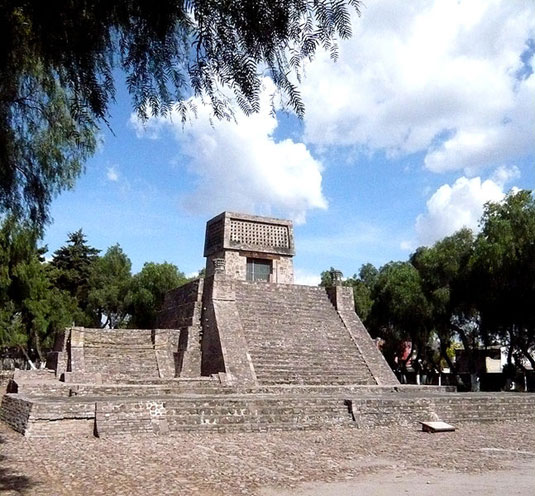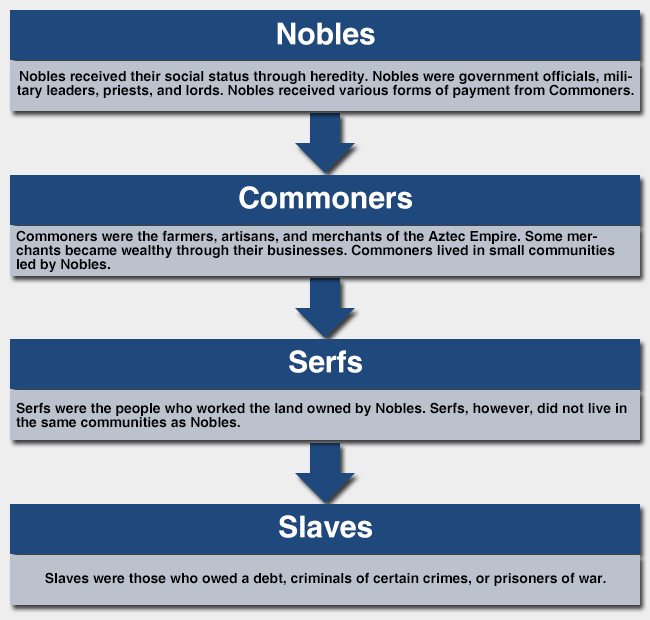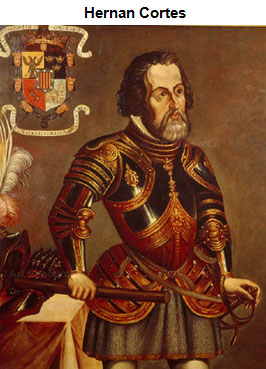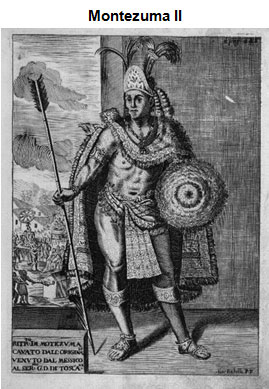

The image above is of a pyramid constructed by the Aztecs, believed to be a nomadic tribe from present-day northern México that became one of the most dominant civilizations in Mesoamerica. Following the previous civilization of the Toltec, the Aztecs came to Mesoamerica in the early 13th century and settled on swamp land which they later drained and where they created a series of manmade islands. Here they established Tenochtitlan around AD 1325.
Click on the link below to learn more about the Aztecs.
![]() Aztec: Tenochtitlán and the Aztec empire
Aztec: Tenochtitlán and the Aztec empire
The Aztec Empire is characterized by a prosperous economy featuring an active market that attracted up to 50,000 people on market days. This was the location where buyers and sellers came to exchange goods and services. The market played such an important role in the empire that it was the subject of many artists who depicted the lives of the Aztecs.
The scene below is from La Gran Tenochtitlan, a mural by Diego Rivera.
![]() Mouse over the blue text, "OPTICS," and analyze the image.
Mouse over the blue text, "OPTICS," and analyze the image.
The Aztecs were a dominant empire mainly because of the alliance that was formed in 1428 between three neighboring Aztec cities: Tenochtitlan, Texcoco, and Tiacopan. Under this alliance, all three city-states provided security for one another and a shared system of economic support. Tenochtitlan was the leader of the alliance; each alliance member maintained a separate religious, legal, and economic system. The alliance disbanded in 1515, with Tenochtitlan gaining control of the Aztec Empire. By the 16th century, the Aztec Empire ruled over 6 million people. At one point, Tenochtitlan was the most populated city in Mesoamerica with more than 100,000 people; it was also the trade center of the Aztec Empire.
The Aztec Empire had a highly structured social hierarchy. Read more below.

The Aztecs had a very sophisticated agricultural system, complete with an elaborate irrigation system that supplied water to the lush gardens on the manmade islands. The Aztecs harvested a variety of crops including tomatoes, potatoes, avocadoes, corn, and beans. The Aztecs also practiced extensive fishing and hunting.
The fall of the Aztec civilization came in 1521. The decline of the civilization began a few years earlier when the first European visited the region in 1517. Francisco Hernandez de Cordoba, impressed with the Aztecs, sent a report of what he observed back to Spain. In 1519 Spanish conquistador, Hernan Cortes arrived in the region and learned more about the Aztecs from other natives, including the Aztecs' enemies.

Against the wishes of the Spanish government, Cortes founded Veracruz, a city along Mexico’s southeastern coast, and prepared his army for battle. He began to create alliances with other natives who were at war with the then emperor of the Aztecs, Montezuma II.

In November 1519, Cortes arrived in Tenochtitlan, where he and his troops were welcomed by Montezuma and the Aztecs. Cortes was suspicious of the Aztecs, though, and feared that the Aztecs might have been plotting to kill the Spanish. The Spanish, although outnumbered by the Aztecs, easily conquered the Aztecs after capturing the nobles. The Aztecs fought back and eventually pushed the Spanish out of the city. The Spanish retreated and were joined by reinforcements from the Spanish Army and other allies. After several battles, the Aztecs were defeated by the Spanish in 1521.
The Aztec civilization fell at the hands of the Spanish, and the ruins of Montezuma's palace are found under present-day downtown Mexico City.
In the lesson, you learned about the civilizations of the Incas, Mayas, and the Aztecs. The Incas, located in present-day western South America, were a rich and powerful civilization known for their agricultural and architectural skills. The fall of the Incas is attributed to the invasion of the Spanish in addition to the Incas’ exposure to smallpox.
The Mayan civilization was quite advanced. The Mayas had an advanced system of writing and even developed paper books. They believed that astronomy had a place in every facet of society. They used astronomy in planting crops, creating calendars, and predicting solar eclipses. The Mayas were one of a few ancient civilizations to develop the concept of zero. It is unclear as to what truly caused the decline of the Mayas, but poor agricultural practices and the spread of European diseases are believed to be the top causes.
The Aztecs, the most powerful and prosperous civilization of Mesoamerica, were known for the creation of Tenochtitlan, its capital city created by the Aztecs on former swampland. The Aztecs had creative agricultural practices and conducted a large-scale market place that served all members of its three alliances. The Aztec civilization fell at the hands of the Spanish, and its ruins were turned into present-day Mexico City.
Sources of images used for this section as they appear, top to bottom: